In search of William Andrews
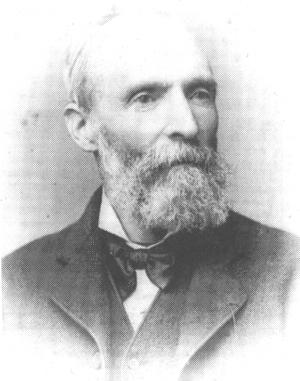
Andy Brockway is a young Canadian -- he's also the great grandson of 19th century Birmingham sewing-machine manufacturer William Andrews. Here he tells what he has so far discovered about his ancestor.
WILLIAM ANDREWS was born 28 February 1839 on Stott Street in Hulme, Manchester, the only child as far as can be told of John Andrews, plainer, and Ann Munro.
They may have come from Scotland as part of a general migration to rapidly-growing industrial centres but efforts to prove this have so far been unsuccessful.
The next 32 years in William's life are a mystery and all we have so far to fill the gaps are family stories. William went to work at the age of nine as a rope walker in Bristol. He may have had some education during this time as he was supposed to have been extremely articulate.
According to one of his grandsons he decided at an early age to go to America for experience and it is here that fact and fiction may blur as reports of fortunes made and lost occur. He was involved in several occupations during a stay that could have lasted 10 to 12 years.
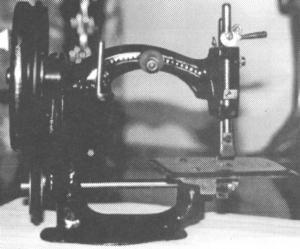
Rare Andrews-named machinefrom the Maggie Snell collection
There are reports of involvement in the automation of ammunition production for the Gatling gun during the American Civil War and the invention of the power takeoff for the founders of Massey Ferguson. He was supposed to have been "cheated" out of the latter because of his own ignorance when he discussed his design with an engineer.
One of the more-interesting stories has him as a construction engineer on the Civil War ship "The Monitor". He and his crew worked around the clock for three days to install the engine in record time.
In recognition of his contribution he was asked to stay on as ship's engineer but declined. Of course the ship was promptly scuttled on its maiden voyage during its first conflict.
Finally, the story with the most merit has him working for the Singer Sewing Machine Company for several years. He is said to have walked nine miles per day from his apartment to the factory.
I have so far been unable to learn if any archives exist to document his time there. He was supposedly offered a position as manager of a new factory being built in Glasgow, Scotland, but declined.
A physician advised him that the climate in America was killing him and that he must return to England. He was also told to cut out the cigars, which he promptly did.
Firm evidence exists that he had returned to England by 1871, for a Birmingham directory places him at 126 Steelhouse Lane with a listing as a sewing-machine maker.
He then disappears in the directories until 1875 when he is listed at 145 Steelhouse Lane. He did, however, apply for and received two patents for sewing machines in 1872 and 1874.
The years had been busy ones for him personally as he met and married Fanny Elizabeth Parkes, the daughter of a local spectacle maker and jeweler, on 23 May, 1874.
His five children: William Richard; Walter Munro; Albert George; Fanny Sarah and Edith May were born between 1874 and 1884 as the family moved to several different locales in and around Aston. In 1878 his address listing is supplemented with a short advertisement that reads:
"Andrews, Wm., 145 Steelhouse Lane; manufacturers of the "Wheeler & Wilson", "Sanspareil" and other sewing machines. These machines are of first-class workmanship and finish. Wheeler & Wilson, £5 5s 0d; Sanspareil, £1 10s 0d".
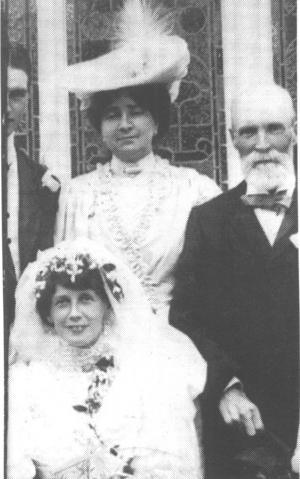
William Andrews with wife Fanny(nee Parkes) to his right at his second son's wedding in 1902
In 1880 he re-located to 3 Steelhouse Lane and, in 1881, the first mention is made of his new career as a bicycle manufacturer.
The story goes that one day a customer arrived in the sewing-machine shop and, after purchasing one, asked if he might place a bicycle he wished to sell in the front window of William's shop.
William replied that if it sold he would go into the bicycle-manufacturing business.
The census of 1881 shows William and his family living at 3 Steelhouse Lane. He is listed as a master machinist employing six men and two boys and he was able to afford one servant.
He continues to be listed as a sewing- machine manufacturer until 1884 when it would appear he closed down these works and moved the bicycle works to Victoria Road in Aston.
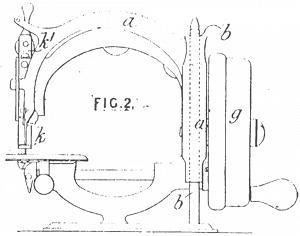
Illustration from Andrews' 1874 patent
The name Sanspareil lived on as the name of his top-line penny farthing. His cycle works lasted until 1902 when it was sold to Triumph. In 1907 William entered what would be his last business venture when he founded, with a business partner Mr. Riley, the United Steel Wire Mill that made spokes for bicycle and motorcycle wheels.
This last company outlasted even its founder and finally folded in the 1970s. William entered semi-retirement in 1910 when he moved permanently from Aston to Bournemouth.
He had initially purchased a house there in the early 1890s on his doctor's recommendation as a more-suitable place for his daughter Edith who suffered from consumption.
Unfortunately she died soon after her arrival but the place was maintained as a summer house. My grandfather, born in 1904, remembered vividly the house known as Chineside.
William was a short man with white hair and long white beard who was often mistaken for George Bernard Shaw. He loved billiards, was a voracious reader and was a loyal member of the Masons. He seemed to have maintained a passion for exercise throughout his life and could out-walk most men half his age.
He would go on daily trips into town along the cliffsides and was still doing so three weeks before his death. He evidently caught the flu, became confined to bed, and died. His will, probated 20 April 1932, showed an estate worth about £9,000.
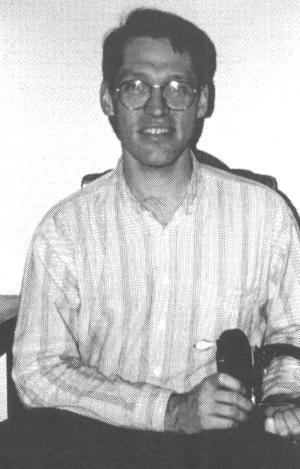
William Andrews' great-grandson Andy Brockway. This picture was taken in London last year when theCanadian was visiting Maggie as part of his research project
He was alleged to have been given a draught by the local doctor to soothe his pain. This physician, so the story goes, was charged years later with killing his wife and several elderly patients with morphine.
An obituary in the March 1932 issue of Sport and Play and Wheel Life reads as follows:
"On February 12 Mr. William Andrews died at the ripe age of 93. Many old inhabitants of Aston will recollect Mr. Andrews' factory, the Sanspareil Works, in Victoria Road, which was probably one of the first, if not the first, cycle factory in Birmingham.
"Here Mr. Andrews made his famous machines, and also made machines for S Bettmann & Co of London, under the transfer of the Triumph. Mr. Andrews was closely associated with Wm. Bown, the inventor of Ball Bearings; Thomas Humber of the Beeston Humber; Edward Mushing of the Centaur; George Singer of Singer & Co; J K Starley of the Meteor Co -- later the Rover; and many other men in the early days of the bicycle.
"We remember in our very youthful days pressing our nose against the showroom window of the factory in Victoria Road, Aston, with great desire to be the owner of the products displayed therein but lacking the necessary wherewithal to fullfil those desires.
"Mr. Andrews had under his charge many men who later became prominent in the cycle industry and some of them are still connected with it, having made their fortunes from the foundations of their apprenticeship with Mr. Andrews.
"He was buried in a simple plot in Parkstone Cemetery just outside of Bournemouth beside his daughter Edith. "






